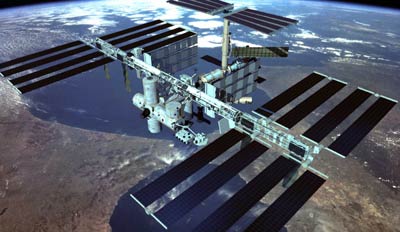Privatizing the ISS: international complicationsby Taylor Dinerman
|
| If the US does decide to abandon the ISS after 2017, it is perfectly conceivable that ESA, with Russia as a member, could take 100 percent control. |
On the other hand, this could bring disadvantages for Europe. In particular, membership in ESA is a signal that Russia will eventually join the EU. The Turkish effort to set up a national space agency, which could become part of ESA, is part of their overall plan to become a full member of the EU. Russia and Turkey seem to feel that joining the EU is a worthwhile national goal. Current member states of the EU may feel otherwise.
If the US does decide to abandon the ISS after 2017, it is perfectly conceivable that ESA, with Russia as a member, could take 100 percent control. They have the capability and, if the European ATV is a success and they can find a way to maintain the seals between the modules, they could conceivably keep the station going almost indefinitely. This option would probably cost two or three billion dollars a year, i.e., the lion’s share of ESA’s budget. Unless there is a radical change in Europe’s space policy, it is hard to imagine ESA and the Russians being willing to take full control of the ISS.
This leaves privatization as the most likely post-2017 option. Yet, a traditional privatization would probably be as unacceptable as an ESA takeover. If there were an auction, an investor might be able to take over the ISS for pennies on the dollar. Even if he or she paid $10 billion for it, that would still be roughly ten percent of what it cost to build. None of the governments involved would want to explain publicly why they spent $100 billion for such a pitiful payoff.
The port authority model, which has been proposed by Rick Tumlinson and the Space Frontier Foundation, makes sense to American ears, but may not be as acceptable to the Europeans or Russians. They would probably prefer a more traditional model of a state-controlled company or a public-private partnership. Whatever the solution, the US will insist on certain rules, mostly having to do with security and liability. For example, the US would not look kindly on the new owners’ leasing out parts of the station to the Chinese military for their operations.
| Handled properly, the privatization of the ISS could set an example for future in-space handoffs from the government to the private sector. For this reason, alone, it is worth beginning to figure out what the US wants, ultimately, to happen to the ISS. |
One basic principal the US side should recognize is that the international partners have a moral “right of first refusal.” They went into this project expecting that the US would insure that the station would be a world-class scientific facility. Due to the Colombia accident, it is possible that the ISS will never reach that goal. It may be completed in 2010 or 2011, but, after the Shuttle is withdrawn from service and before the CEV is ready, there will be a period of three or four years when the only access will be via Soyuz. At least that is the only reasonable current assumption; Burt Rutan may have other ideas. In any case, the idea that a seven-person crew will live and work on the ISS for long periods of time seems, for now, to be out of the question.
The US now wants to concentrate its scientific work onboard the ISS on human factors research for long-duration spaceflight. NASA’s apparent rejection of the Russian proposal to keep two-man expeditions onboard for up to a year thus seems a little strange. Could this be yet another example of the dysfunctional way the Washington bureaucracy has of responding to unanticipated situations?
In any case, the US has a responsibility to its partners and to itself to properly plan for the post-2017 life of the ISS. Letting the station follow Mir into the Pacific would be a major blunder and discredit America as an international space partner for decades to come. Handled properly, the privatization of the ISS could set an example for future in-space handoffs from the government to the private sector. For this reason, alone, it is worth beginning to figure out what the US wants, ultimately, to happen to the ISS. Without setting clear goals, NASA cannot effectively propose anything to the other governments involved. They have only twelve years to figure this out. It’s a sad commentary on the way the world works, but it will probably take them that long to come up with an agreement.
